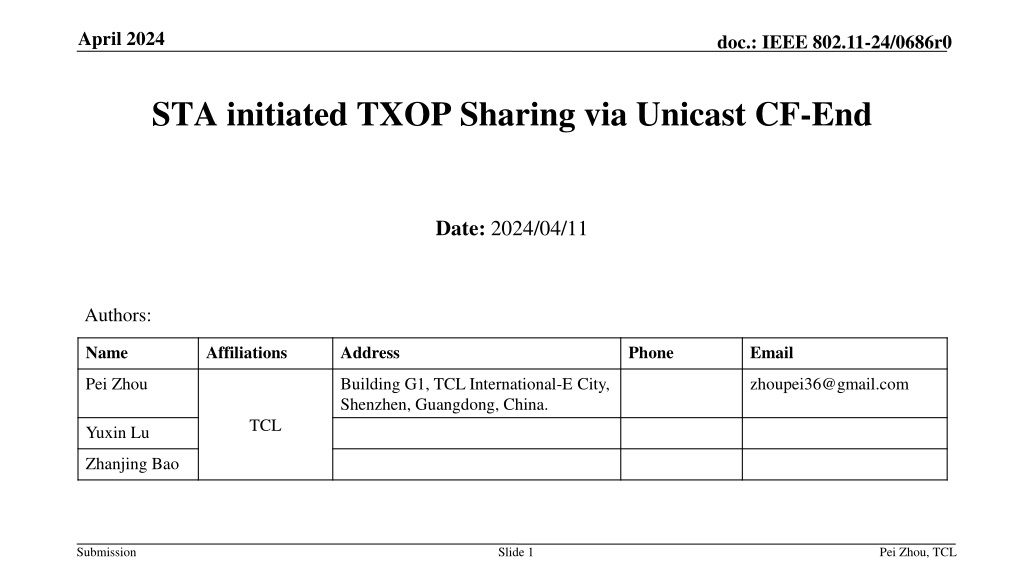

0 likes | 11 Views
In this document, Pei Zhou from TCL presents a proposal for supporting a mechanism where a non-AP STA shares its obtained TXOP with an associated AP through a unicast CF-End frame in IEEE 802.11-24/0686r0. The proposal outlines rules and mechanisms for efficient resource utilization, low latency, and prioritization of control traffic. It addresses the drawbacks of existing trigger frames and suggests using a unicast CF-End frame for STA-initiated TXOP sharing. The document discusses the frame formats, truncation of TXOP, and rules for both non-AP STA and AP in implementing this sharing mechanism.

E N D
April 2024 doc.: IEEE 802.11-24/0686r0 STA initiated TXOP Sharing via Unicast CF-End Date: 2024/04/11 Authors: Name Affiliations Address Phone Email Pei Zhou Building G1, TCL International-E City, Shenzhen, Guangdong, China. zhoupei36@gmail.com TCL Yuxin Lu Zhanjing Bao Submission Slide 1 Pei Zhou, TCL
April 2024 doc.: IEEE 802.11-24/0686r0 Introduction In this contribution, we propose the mechanism and related rules to support a non-AP STA shares its obtained TXOP with associated AP through unicast CF-End frame. Submission Slide 2 Pei Zhou, TCL
April 2024 doc.: IEEE 802.11-24/0686r0 Re-cap: STA initiated TXOP Sharing The following references (including but not limited to) proposed non-AP STA initiated TXOP sharing for 802.11bn • [1] 11-23/0581, Non-AP initiated TXOP sharing, • [2] 11-23/1847, Follow-up on a non-AP STA initiated TXOP sharing, • [3] 11-23/1874, Reverse TXOP sharing proposed. Benefits of non-AP STA initiated TXOP sharing: [3] • Efficient resource utilization • Low latency and control traffic prioritization • QoS management • … Existing solution(s): • [1] [2]: Control frame (could be a new variant trigger frame) transmitted by a non-AP STA • [3]: The 802.11 specification changes required in UHR are minimal. They can simply be an extension of the 11be TXS modes 1 and 2. Drawback(s) of using Trigger (a new variant or MU-RTS TXS TF) frame: • Trigger frame is too long and contains many unnecessary fields for non-AP STA’s TXOP sharing • So far, 802.11 baseline doesn't support non-AP STA transmitting Trigger (a new variant or MU-RTS TXS TF) frame Submission Slide 3 Pei Zhou, TCL
April 2024 doc.: IEEE 802.11-24/0686r0 Re-cap: CF-End frame and Truncation of TXOP The frame format for the CF-End frame is defined as below: [4] When transmitted by a non-DMG and non-S1G STA, the Duration field is set to 0. When transmitted by a non-DMG STA, the RA field is the broadcast address. When transmitted by a DMG STA, the RA field is the MAC address of the STA that is the intended immediate recipient of the individually addressed Data or Management frame, or the broadcast address. • • Truncation of TXOP [4] • By transmitting the CF-End frame, the STA is explicitly indicating the completion of its TXOP. Submission Slide 4 Pei Zhou, TCL
April 2024 doc.: IEEE 802.11-24/0686r0 Proposal: Unicast CF-End frame for STA initiated TXOP Sharing In 802.11bn, we propose to define the following new mechanism and rules to support STA initiated TXOP Sharing: • Mechanism: Non-AP STA shares its obtained TXOP with associated AP by transmitting a unicast CF-End frame. • STA rules: 1) Non-AP STA can set the RA field of CF-End frame to a unicast address (i.e., AP’s MAC address); 2) (Optional) When the RA field of CF-End frame is set to a unicast address (i.e., AP’s MAC address), the non-AP STA can indicate the shared TXOP duration in the Duration field of CF-End frame; 3) The BSSID(TA) field is set to the non-AP STA’s MAC address. • AP rules: 1) When an AP receives a CF-End frame and finds that the RA field is equal to its MAC address (which means the RA is set to a unicast address, rather than a broadcast address), the AP assumes that the non-AP STA transmitting the frame announces to share its TXOP; Note: Only associated AP receives the CF-End frame, other STAs’ NAVs are still set to the end of the current TXOP; 2) (Optional) the duration of shared TXOP is signaled in the Duration field of the unicast CF-End frame; 3) AP can use the shared TXOP to initiate new transmissions with other non-AP STAs SIFS (TBD) after the CF-End frame. Operations controlled by AP SIFS 3 AP TXOP shared by the non-AP STA TXOP of AP (320 MHz) TXOP sharing CF-End frame (unicast) … PPDU Non-AP STA 0 TXOP obtained by the non-AP STA Slide 5 Submission Pei Zhou, TCL
April 2024 doc.: IEEE 802.11-24/0686r0 Discussions and Next Steps How does AP return the shared TXOP (if there is still remaining time)? • Is it necessary to return? • If not necessary, AP can simply broadcast CF-End frame to terminate the current TXOP and start new channel contention. • If necessary, AP may use MU-RTS TXS TF (as defined in 11be) to share the remaining time to the “original” non-AP STA. How does non-AP STA indicate its shared bandwidth (channel)? How does AP expand more bandwidths (channels) than non-AP STA’s sharing? Submission Slide 6 Pei Zhou, TCL
April 2024 doc.: IEEE 802.11-24/0686r0 Straw Poll 1 Do you agree to add the following text to the TGbn SFD: Non-AP STA can sharing it obtained TXOP with associated AP. Note: the detailed method is TBD. Y/N/A Submission Slide 7 Pei Zhou, TCL
April 2024 doc.: IEEE 802.11-24/0686r0 Straw Poll 2 Do you agree to add the following text to the TGbn SFD: Non-AP STA can sharing it obtained TXOP with associated AP by transmitting an unicast CF- End frame, and the RA field is set to associated AP’s MAC address. Note: the detailed rules are TBD. Y/N/A Submission Slide 8 Pei Zhou, TCL
April 2024 doc.: IEEE 802.11-24/0686r0 References [1] 11-23-0581-00-0uhr-non-ap-initiated-txop-sharing [2] 11-23-1847-00-00bn-non-ap-initiated-txop-sharing-follow-up [3] 11-23-1874-00-00bn-reverse-txop-sharing [4] Draft P802.11REVme_D5.0 Submission Slide 9 Pei Zhou, TCL